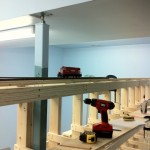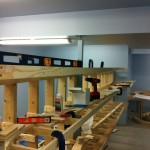Got up this morning, had breakfast, and went downstairs to do some cleanup, and to start building #8 turnouts. Got one LH built, which will end up either at the South Siding Switch of Mud Bay, or the Junction Switch at Parksville. In either event, it is needed much sooner than later.
Later in the morning, Cam came over and we got to work. Progress on the helix was already up to the point where we were at the midpoint, and needing trackage to get in and out of the helix from the middle deck of the layout. We had already cut the pieces of wood to graft onto the helix pieces, but ran out of time to get the other bits cut, secured, and whatnot to get them all working together. Today was the day to make that happen.
So, we got the Victoria Sub connection into the helix attached (after much test fitting and rasping to get a clean tight joint) with a couple splice plates made from Baltic Birch and plenty of glue (oh yeah, the other task from the morning was refilling the yellow carpenter’s glue bottle – works much better now!) and clamps.
While Cam was taking care of the dryfitting, I got the subroadbed boards for Parksville Yard and the Port Sub trimmed to a much better size, and looking really good. Once the connection piece into the helix was secured, we secured down the subroadbed boards with plenty of screws.
Following that, the connection to the Port Sub into the helix came in and after much debate as to the height of the helix, figured it was good where it was and secured it very firmly to the two walls it sits against. The thing is not moving at all! We can now start running track within Parksville and then into the helix and carry that up to the top. All I need to get done are a few more turnouts, cork laid, and then we can lay track, wire it up and perhaps have a bit of switching going on at Parksville.
Towards the end of the day, we liberated more than a few pieces of rolling stock from their boxes, including a CP Rail GP35, hitched them all together and ran them up the helix at around 30% power from the powerpack. No issues whatsoever, so I’m figuring if all works well, 3 locos should have no problems hauling 18 cars up to Port Alberni.
A great day for progress. Yes, I’m sure you’re wanting pictures. No, I haven’t taken them yet. Patience grasshopper…



Recent Comments